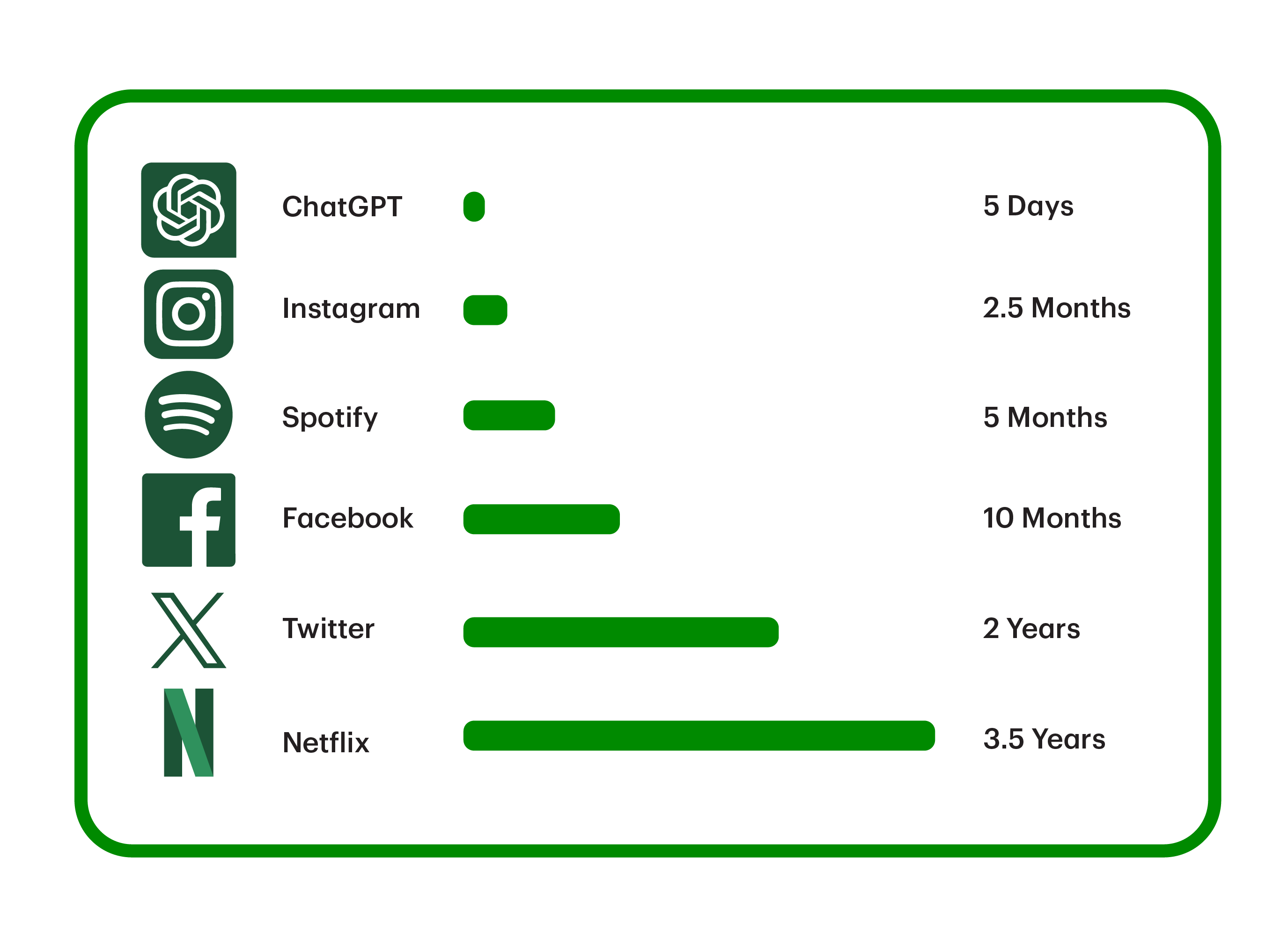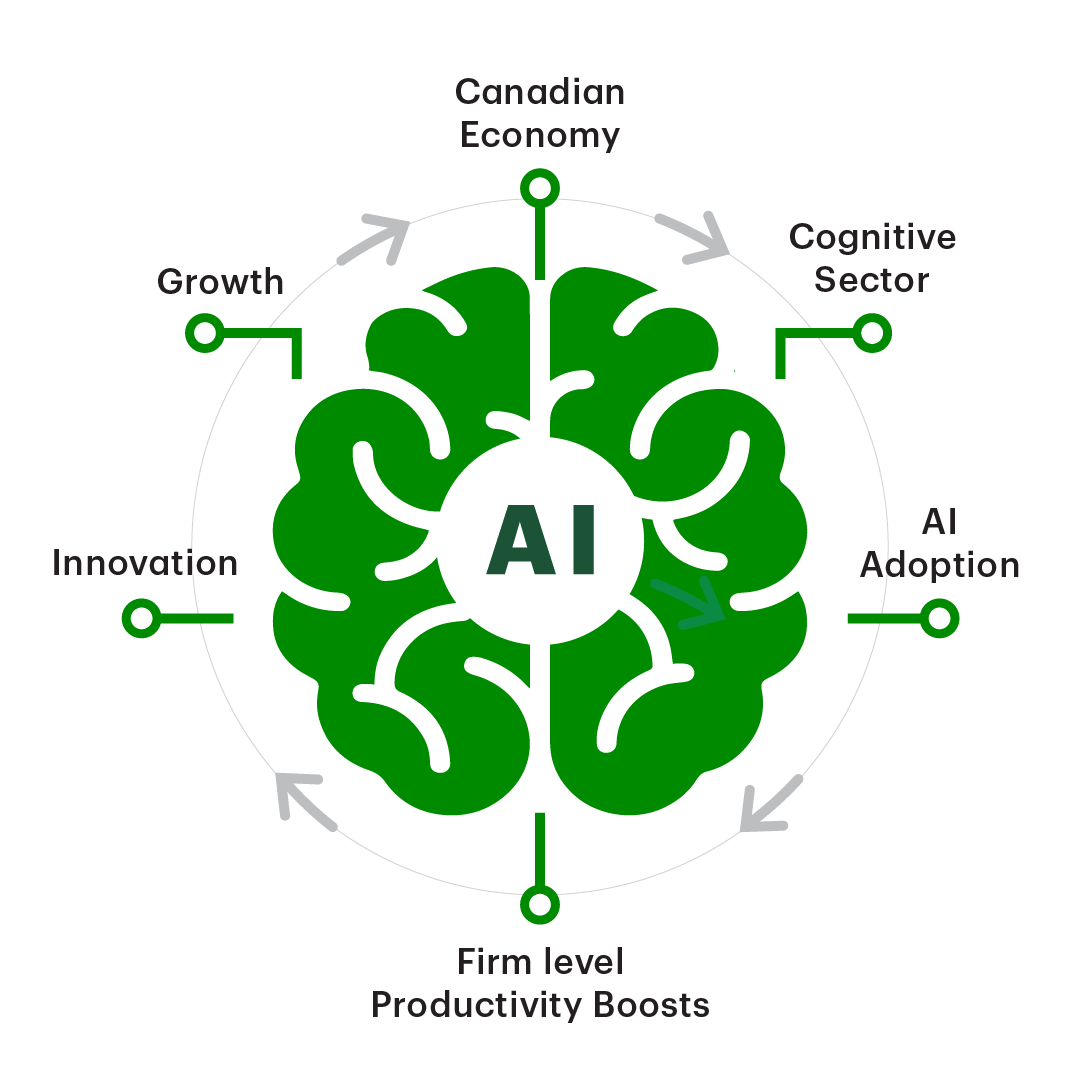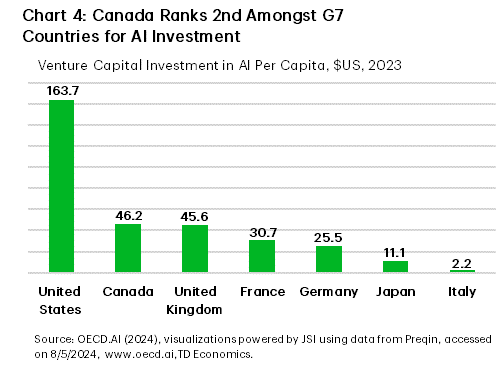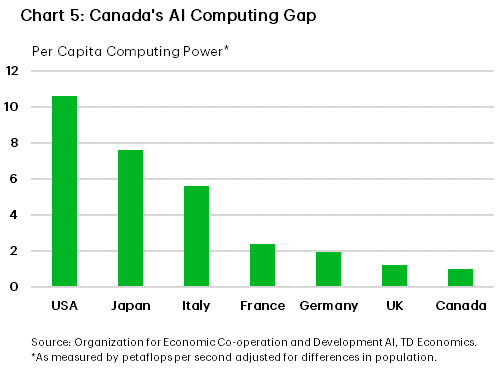Artificial Intelligence Technologies Can Help Address Canada’s Productivity Slump
Rannella Billy-Ochieng’, Senior Economist | 416-350-0017
Anusha Arif, Economic Analyst
Daniella Garcia, Corporate Communications and Design Specialist
Date Published: May 28, 2024
- Category:
- Canada
- Labour
- Consumer
- Commodities & Industry
Highlights
- Canada has a productivity problem and artificial intelligence (AI) driven innovations may offer a remedy.
- The latest advancement in this general-purpose technology is manifesting with great speed and some experts
believe that AI will be the leading technology of the next Industrial Revolution. - Canada’s unique AI ecosystem provides a good starting position for us ride this industrial growth wave, but poor
adoption policies and weak AI preparedness may derail this opportunity. - In the more optimistic scenario, the adoption of AI across industries could lead to an output increase of 5%-8%
over the baseline over the next decade.

Canada has a longstanding productivity problem. Simply put, Canada’s economy has struggled to find ways to boost the productivity of workers. While weak investment explains some of Canada’s productivity underperformance, much of the malaise in recent decades has been due to a slowing rate of technological change. Total factor productivity, which captures the change in economic output not attributable to increased inputs, has been slowing since the 1960s. For the past two decades, total factor productivity has, on average, subtracted from labour productivity (Chart 1). When an economy struggles with weak productivity, living standards often erode. At the same time, having a smaller productive bandwidth makes it harder to fight inflation, since it shrinks the potential at which a country can grow without stoking inflationary embers.
Technology that boosts innovation and the rate of technological change could inject life back into Canada’s growth trajectory. Advancement in generative artificial intelligence (AI) technologies is currently taking place at a rapid speed and may spur faster productivity gains. As a general-purpose technology, generative AI has a broad reach because the innovation offered by AI interfaces with existing and widely available technological infrastructure such as computers, tablets, and handheld devices. These technologies have the potential to boost productivity, particularly of cognitive workers who can apply it to their everyday jobs. Canada is well placed to embrace this next wave of digital transformation. Canada’s AI ecosystem stands out as a premium product and is home to a high concentration of generative companies and world-ranking talent. While the talent pipeline is promising, Canadian businesses have poor AI adoption rates relative to their U.S. peers. The absence of widespread adoption and commercialization of AI among business could stand in the way of Canada fully capitalizing on this nascent opportunity.

Cognitive Machines: Making People Work Smarter
We may well be on the brink of a technological revolution that will alter the way we work. Like past waves of growth-inducing technological change, AI is not specific to any one industry, but is rather a general purpose technology that can be utilized broadly across the economy. What makes it different is how quickly it could be implemented. Past waves of innovation, such as the mechanization of manufacturing during the Industrial Revolution, or the introduction of computers in the 20th century, took decades to play out (see Text Box below). Generative AI could break that mold, with signs that it is being introduced to consumers at a record speed. While it took Netflix 3.5 years and Instagram 2.5 months to reach 1 million users, Chat GPT shattered records by achieving this milestone in a mere 5 days (see Graphic above). The implications are profound and immediate. Research from the OECD suggests that given the recent ease of use in language and image-generating models, the speed of diffusion may be faster than previous technological waves.1 However this possibility hinges on complementary investments in things that improve AI preparedness (e.g. data, training, digital infrastructure & capabilities).2
Generative AI stands out from earlier automation waves in other important way. While past waves of innovation were helpful at automating routine and repeatable tasks, generative AI stands out for its ability to solve complex problems and mimic human cognitive abilities. All industries are likely to benefit from AI; however, the impact will likely to be most transformational in sectors that rely on knowledge work, such as technology, financial services, banking, pharmaceuticals, medical products, and education.
Four Waves of Industrial Revolution
- The Industrial Revolution started in the late 18th century with the use of steam power, which allowed for massive generation of useful energy.
- By the arrival of the second Industrial Revolution in the 19th century, electric power helped to create mass production and mechanized manufacturing.
- The third Industrial Revolution used electronics and information technology to automate production in the 20th century.
- We are arguably now in the fourth Industrial Revolution that builds on the digital revolution and can be characterized as a fusion of technology, which blurs the lines between physical, digital, and biological spheres.
(Source: World Economic Forum - The Fourth Industrial Revolution, What it Means and How to Respond, The Second Machine Age, Work Progress and Prosperity in a Time of Brilliant Technology)
Demystifying Fear About Widespread Job losses

Although AI has the potential to bolster growth, critics worry that the rise of cognitive machines will create widespread job losses. However, history has shown that technological advancement tends to be positive for employment in the long run, and past fears about widespread job losses did not materialize.
The natural course of the jobs market is to evolve with the creation of new technology. When it comes to the impact of generative AI on employment, early empirical evidence suggest that AI is more complementary to labour than it is displacing.3 Even as AI displaces some workers, the productivity effect boosts aggregate demand and the increase in demand for workers could dominate the substitution effect.4
While most jobs in advanced economies are exposed to AI, the high concentration of cognitive-based occupations in advance economies, means a huge opportunity for complementary roles (Chart 2). Empirical evidence show that college-educated workers are better prepared to move from at-risk jobs to complementary jobs, thereby bolstering their ability to ride this innovation wave.5 Canada’s high concentration of highly-educated workers suggests that there are reasons for optimism in workers ability to adapt.
From Efficiency to Economic Growth

Cognitive machines have the potential to help workers perform more efficiently and could even augment the creation of innovative ideas.6 To assess how much generative AI could boost economic growth, we need to appreciate how AI technology interacts with labour. Activities exposed to AI are the tasks that can be executed with the help of a technology, either augmenting or substituting for labour.
As a first step we mapped out the cognitive economy using two methods. First, we identified the share of compensation paid to high-skilled jobs that require a degree and those in management or specialized roles (Chart 3). Secondly, we deconstructed occupations through a task-based lens to isolate jobs that are likely to be complemented by AI and have medium risks of automation.7 Taken together we have a range of estimate for the cognitive sector (52%-68%), which captures the share of workers likely to be exposed to generative AI. That range is comparable to the IMF’s estimated share of workers in high-exposure occupations living in advanced economies.8
More productive workers will have broader implications on firm level performance. Earlier research shows that estimated the effect of AI on firm level productivity ranges from 0%–11%.9 We applied conservative estimates of firm level productivity. More recent studies that look specifically at generative AI, suggest that it has the potential to boost the productivity of tasks by 10%-56%. Since these results were observed in frontier companies, we were cautious not to generalize those estimates. Understanding that the diffusion of technology takes years, we incorporated a phase in period of ten years and assume that roughly half of Canadian companies will embrace the technology by then.
The potential for AI to boost economic growth starts with the increased efficiency of output and extends to the acceleration of innovation – which helps to spur future productivity growth (see graphic below).10 Based on the share of jobs in AI-complementary occupations, our analysis suggests that with adoption ramping up, Canada’s real GDP could be up to 5%–8% higher in the next ten years than our current baseline. That implies a 0.5%–0.7% lift to annual-producitivty that will help to offset some of headwinds from an ageing workforce.
If a larger share of workplace occupations integrates AI or use the technology for more complex tasks, then this would push the productivity impact even higher. Research from the IMF shows AI has the potential to generate up to a 1.5 percentage point increase in workers’ average annual productivity growth rate in the United Kingdom.11 Other studies report a similar average lift of ~1%.12 Benchmarking our results shows consistency with earlier waves of technological innovation, which recorded productivity boosts of 1.3% per year for electricity and 0.8% for ICT.13

Canada’s unique AI ecosystem
Canada’s generative AI ecosystem is globally competitive and is an innovation hub for top AI talent. As a result, Canada ranks second among G7 countries in its concentration of venture capital AI Investments on a per capita basis (Chart 4). Canada is also a top player in the number of Generative AI companies on a per capita basis.14
While Canada has the AI brain and is home to many startup companies, there are several bottlenecks that stifle growth opportunities. For one, Canada is plagued by weak computing horsepower and has the lowest per capita compute performance among G7 peers. (Chart 5). Most computing infrastructure is in other countries, and this challenges Canadian AI firms.15 Stakeholders also worry that the regulation in the Artificial Intelligence and Data Act AIDA, (introduced as part of Bill C-27), may hinder innovation, and needs some work to hedge against that.16 With new rules coming into effect, some businesses will need time to digest how their workplace policy needs to evolve to appropriately manage privacy laws, employment duties etc. Ultimately this could create a learning curve that will take time to climb.


The potential for generative AI to have widespread impacts on the economy is clear but the ability and pace of AI to influence growth will be filtered through the decisions of firms, individuals, and governments. Despite having a strong AI ecosystem, Canadian business lag their peers in their AI adoption. IBM’s global survey of IT professionals shows that Canada has the second lowest adoption rate among G7 countries (22% vs 26.6%).17 Canada’s low adoption rate may be linked to the fact that small businesses are an important fabric of Canada’s economy. AI usage is less prevalent among small firms and many struggle to scale.

Research from Statistics Canada shows that firms in the information and cultural industries, professional, scientific, and technical services and finance and Insurance have the highest adoption rate. Early movers are embracing this technology and generative AI is touching different aspects of our life, including wildlife management, fraud detection and enhancing the customer experience (See adoption graphic above).
Bottom Line
Canada’s struggle with anemic labour productivity is a well-established issue. Developments in Artificial Intelligence can help to answer some of Canada’s productivity woes. Generative AI – a general purpose technology with the ability to mimic cognitive skills – has the potential to be one of the most influential innovations of the fourth Industrial Revolution.18 These technologies will change the way we work, and by helping workers become more efficient, will foster greater economic growth. Canada has a globally competitive AI ecosystem and is well placed to capitalize on this opportunity. However, the extent to which AI technologies can boost growth hinges upon meaningful adaption. To secure our place in global AI ecosystem it is critically important to see more firms embrace the opportunity.
End Notes
- Filippucci et al. (2024) “The impact of Artificial Intelligence on productivity, distribution and growth: Key mechanisms, inital evidence and policy challanges”. OECD Artifical Intelligence Papers
- Calvino, F. and L. Fontanelli (2023), “A portrait of AI adopters across countries: Firm characteristics, assets’ complementarities and productivity”, OECD Science, Technology and Industry Working Papers, No. 2023/02, OECD Publishing, Paris,https://www.oecd-ilibrary.org/science-and-technology/a-portrait-of-ai-adopters-across-countries_0fb79bb9-en
- Hayton et al. (2023), “What drives UK firms to adopt AI and robotics, and what are the consequences for jobs? “Institute for the Future of Work.
- Philippe Aghio (2024) The growth and Employment Effects of AI, Emerging Tech Economic Research Network, San Francisco Federal Reserve. And Cook (2023) Generative AI, Productivity, the Labour Market and Choice Behavior, NBER Economics of AI Conference
- Pesquisa Nacional por Amostra de Domicílios Contínua; UK Labour Force Survey; and IMF staff calculations and Cazzinga et al(2024) showed the life-cycle profile of employment shares by education level for Brazil and the United Kingdom
- Philippe Aghion, Céline Antonin, Simon Bunel (2019). Artificial Intelligence, Growth and Employment: The Role of Policy. Economie et Statistique / Economics and Statistics, 2019, 510-511-512, pp.150 - 164. (https://sciencespo.hal.science/view/index/identifiant/hal-03403370)
- Task identified as Bottlenecks to automation were partially informed from research from Automation, Skills, Use and Training OECD Social Employment and Migration Working Papers, CD Howe,
- Cazzaniga and others. 2024. “Gen-AI: Artificial Intelligence and the Future of Work.” IMF Staff Discussion Note SDN2024/001, International Monetary Fund, Washington, DC.
- THE IMPACT OF ARTIFICIAL INTELLIGENCE ON PRODUCTIVITY, DISTRIBUTION AND GROWTH © OECD 2024
- Martin Neil Baily, Erik Brynjolfsson, and Anton Korinek (2023) “Machines of mind: The case for an AI-powered productivity boom, Brookings
- Cazzaniga and others. 2024. “Gen-AI: Artificial Intelligence and the Future of Work.” IMF Staff Discussion Note SDN2024/001, International Monetary Fund, Washington, DC.
- Andre, C. and P. Gal (2024), “Reviving productivity growth: A review of policies”, OECD Economics Department Policy Paper, forthcoming. Research quoted in the work of Filippucci et al. (2024)
- Artificial Intelligence Commission of France, 2024
- Deloitte (2023) , Impact and Opportunities: Canada’s AI ecosystem. Report produced by Deliotte on behalf of CIFAR, Amii, Mila and the Vector Institue
- https://www.canada.ca/en/department-finance/news/2024/04/remarks-by-the-deputy-prime-minister-on-securing-canadas-ai-advantage.html
- Torys https://www.torys.com/en/about-us/news-and-media/2023/12/ai-regulation-in-canada
- IBM Global Adoption Index November 2023
- Generative AI: A Turning Point for Labor’s Share? Federal Reserve Bank of Philadelphia Research Department (2024) Lukasz A. Drozd and Marina M. Tavares
Disclaimer
This report is provided by TD Economics. It is for informational and educational purposes only as of the date of writing, and may not be appropriate for other purposes. The views and opinions expressed may change at any time based on market or other conditions and may not come to pass. This material is not intended to be relied upon as investment advice or recommendations, does not constitute a solicitation to buy or sell securities and should not be considered specific legal, investment or tax advice. The report does not provide material information about the business and affairs of TD Bank Group and the members of TD Economics are not spokespersons for TD Bank Group with respect to its business and affairs. The information contained in this report has been drawn from sources believed to be reliable, but is not guaranteed to be accurate or complete. This report contains economic analysis and views, including about future economic and financial markets performance. These are based on certain assumptions and other factors, and are subject to inherent risks and uncertainties. The actual outcome may be materially different. The Toronto-Dominion Bank and its affiliates and related entities that comprise the TD Bank Group are not liable for any errors or omissions in the information, analysis or views contained in this report, or for any loss or damage suffered.
Download
Share: